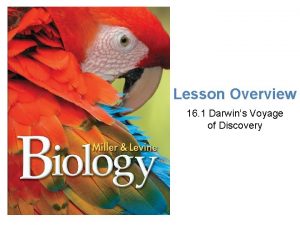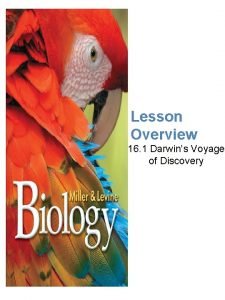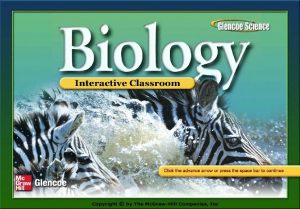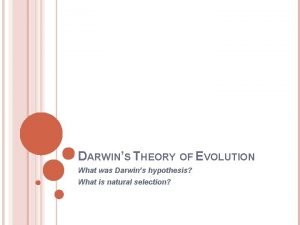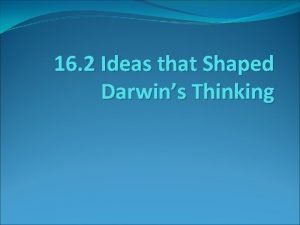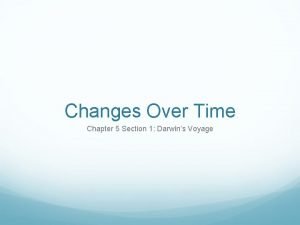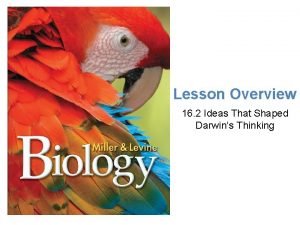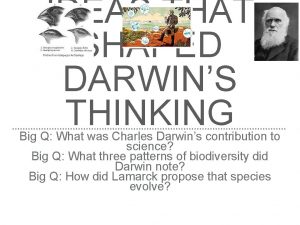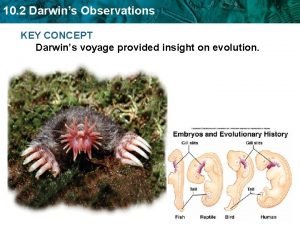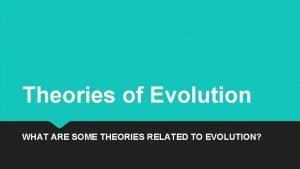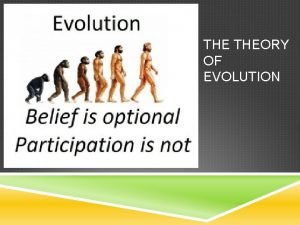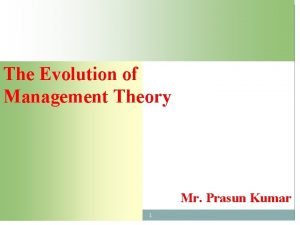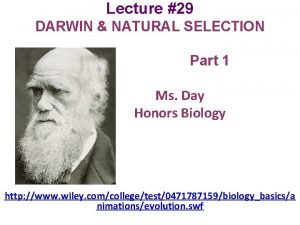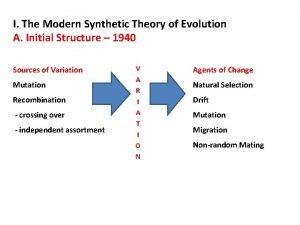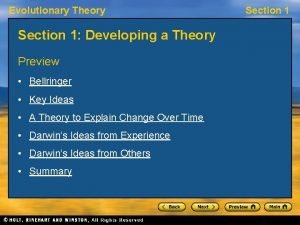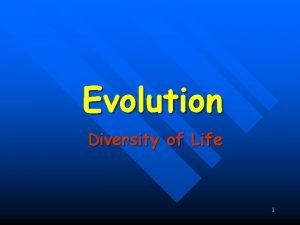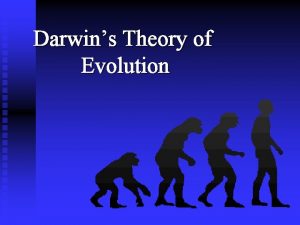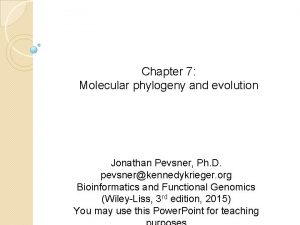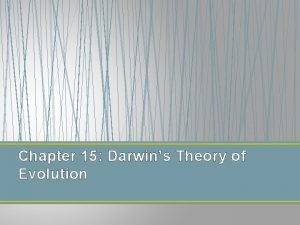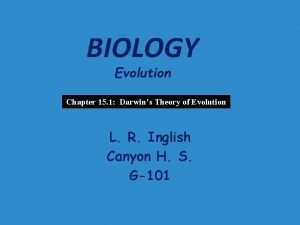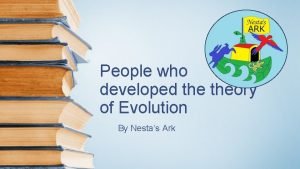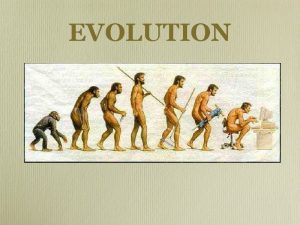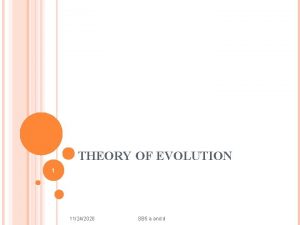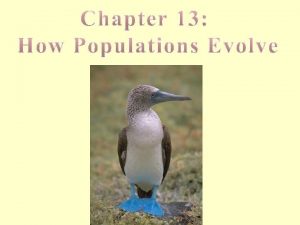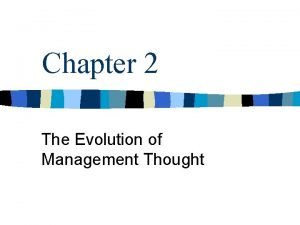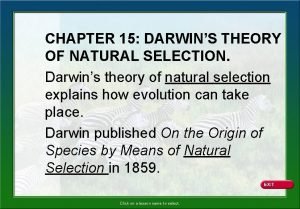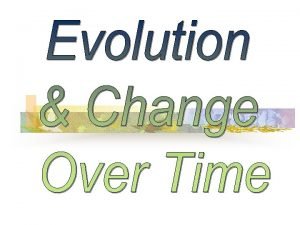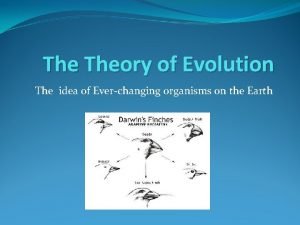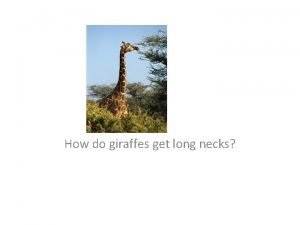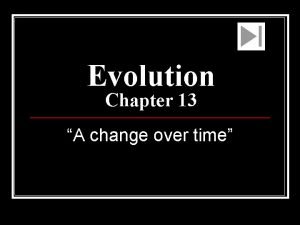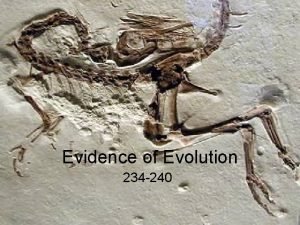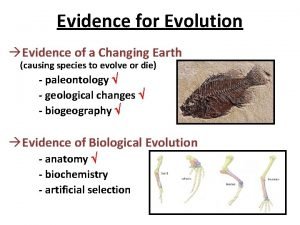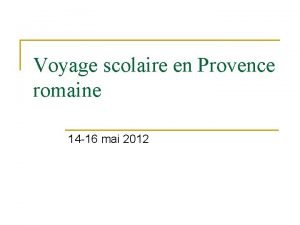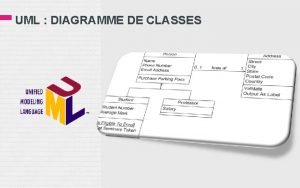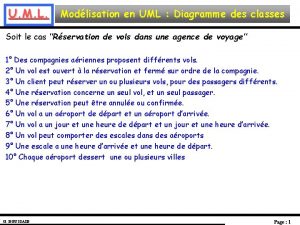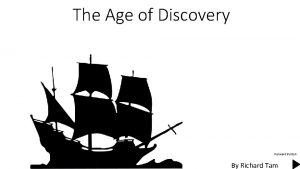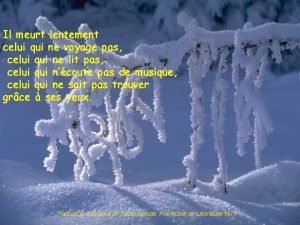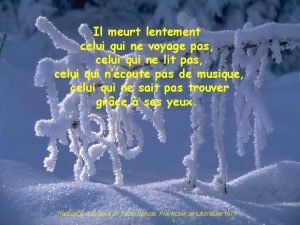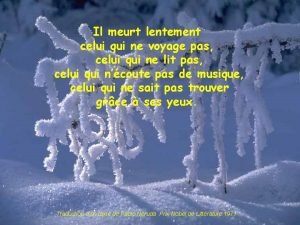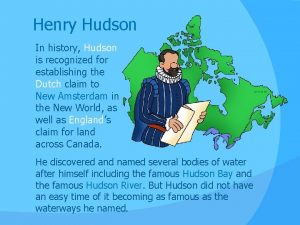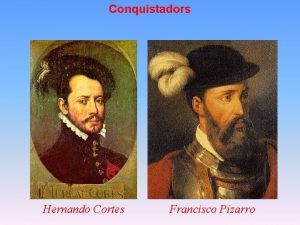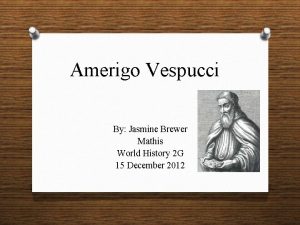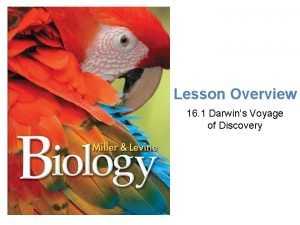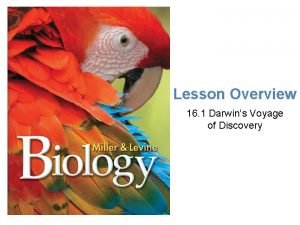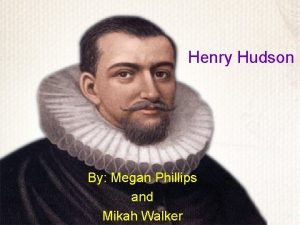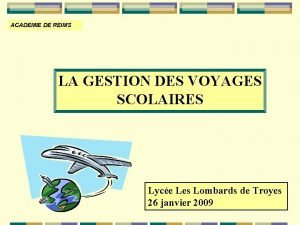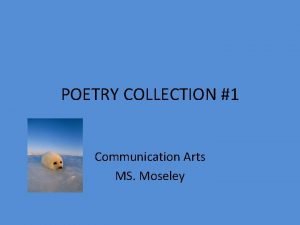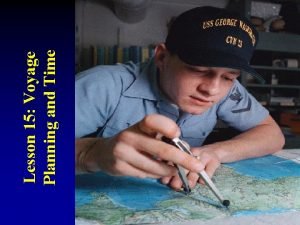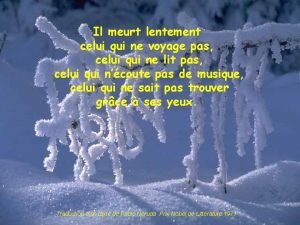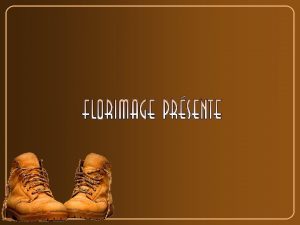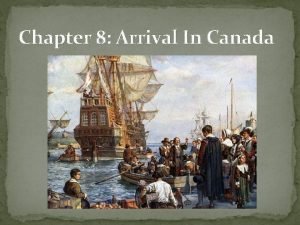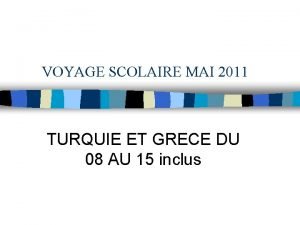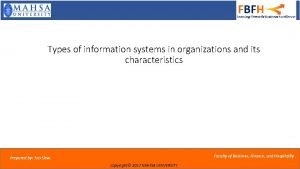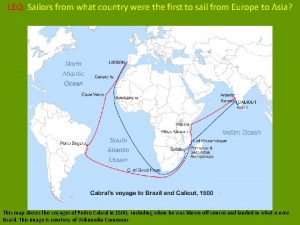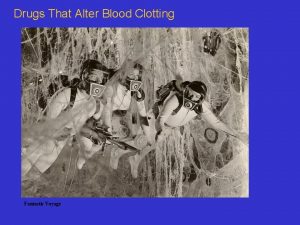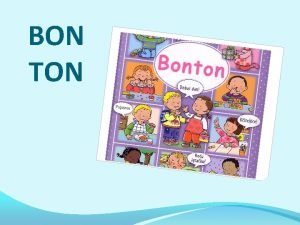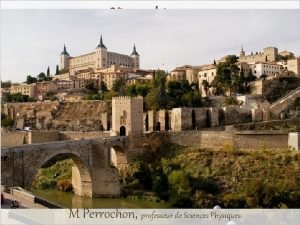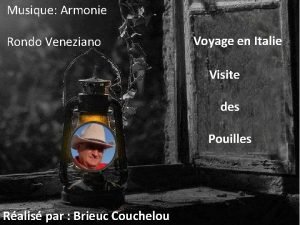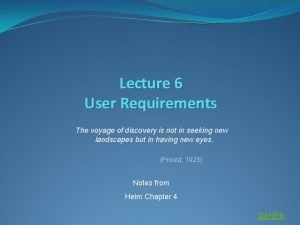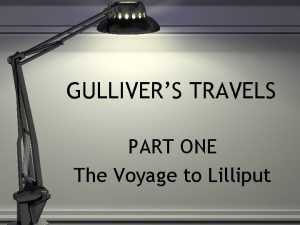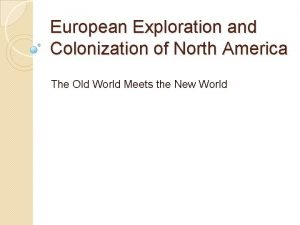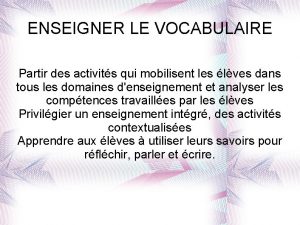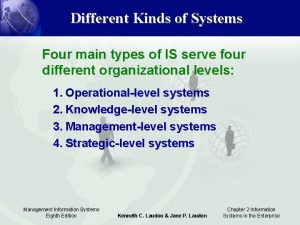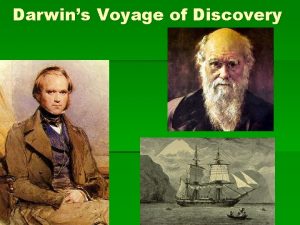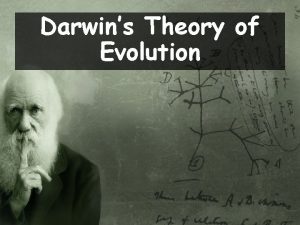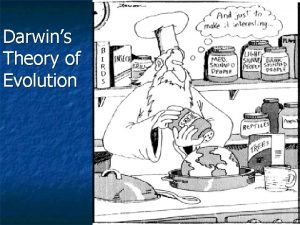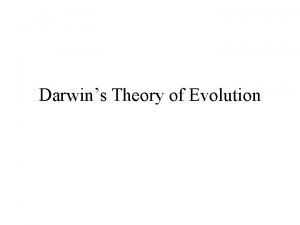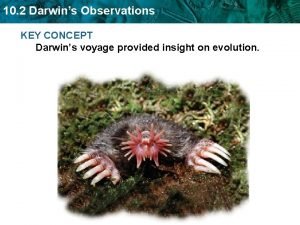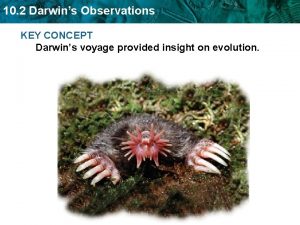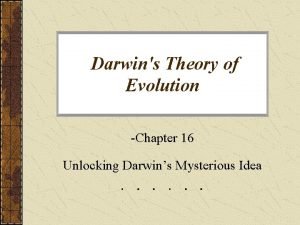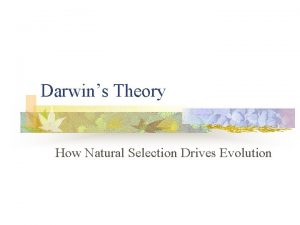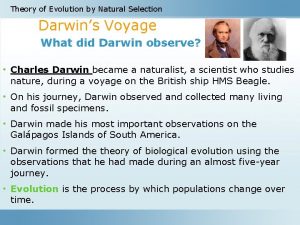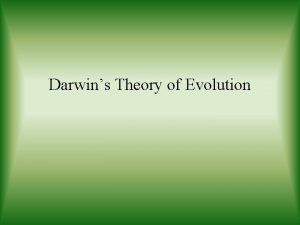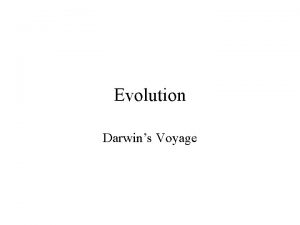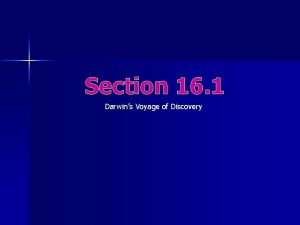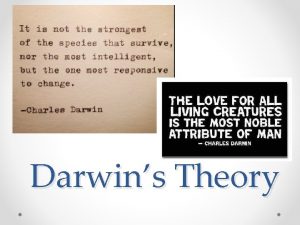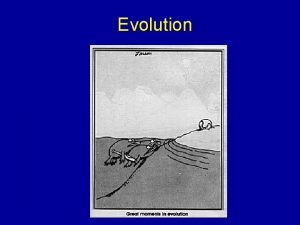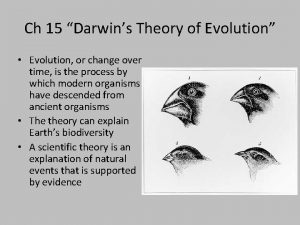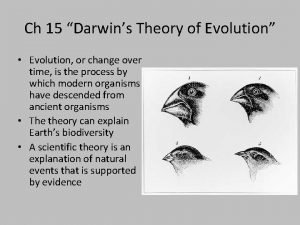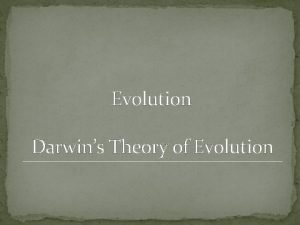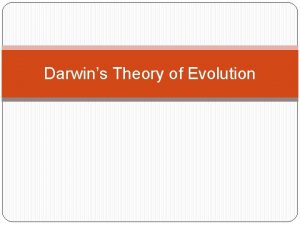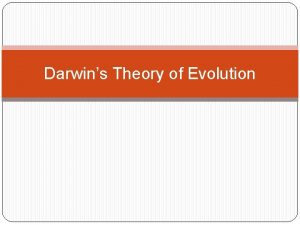Darwins Theory of Evolution 16 1 Darwins Voyage







































































































- Slides: 103

Darwin's Theory of Evolution

16 -1 Darwin’s Voyage of Discovery Darwin’s Epic Journey He was born February 12 th 1809 This year we celebrate his 206 th birthday!! Darwin developed the biological theory of evolution that explains how modern organisms evolved over long periods of time through descent from common ancestors

In 1831, he began a 5 year voyage on the HMS Beagle that would change his life.

Observations Aboard the Beagle Species Vary Globally Different, but similar, animals inhabited separate, but similar, habitats That some similar environments have very different animals. (Kangaroos in Australia but not England)

Species Vary Locally Different, yet related, animals occupied different habitats within a local area Exs. – Tortoises and Birds in the Galapagos Islands varied from island to island


Species Vary Over Time Some fossils of extinct animals were similar to living species Ex. – Extinct giant armored Glyptodont is similar to and lived in the same area as the Armadillo

Giant Ground Sloth Modern Sloth

Putting the Pieces of the Puzzle Together Darwin thought about the patterns he’d seen on his voyage He realized that there were many similarities between the animals he’d seen There was evidence that suggested that species were not fixed and that they could change by some natural process

16 -2 Ideas That Shaped Darwin's Thinking An Ancient, Changing Earth The Earth is very ancient and is continuously changing. – Hutton and Lyell helped scientists see that the Earth is millions of years old. – The geologic processes that shaped the Earth happen very slowly and are still happening today.

Hutton and Geological Change Hutton proposed that rocks form very slowly and are changed by forces that twist, lift and fold them He also realized that mountains can be worn down by rain, wind, heat and cold In order for these events to occur, he concluded that the Earth must be more than a few thousand years old


Lyell’s Principles of Geology Believed that the geological processes we see today must be the same ones that shaped Earth millions of years ago There needed to be enough time in Earth’s history for these changes (like a river carving out a canyon) to take place He agreed with Hutton that the earth was much older than a thousand years


Darwin’s Observations While in South America, Darwin witnessed an earthquake that was strong enough to lift the rocky shoreline 3 meters out of the sea – with mussels and other sea life clinging to it Later, he observed fossils of marine animals in mountains thousands of feet above sea level

Darwin’s Observations Darwin felt this was evidence that Lyell was correct Earthquakes could, over time, build mountains a few feet at a time He asked himself, If the Earth could change over time, could life change too?

Lamarck’s Evolutionary Hypotheses Proposed that the use or disuse of organs caused organisms to gain or lose traits over time. These new characteristics could be passed on to the next generation.

Ex. - A water bird’s long legs happen because the animal kept wading in deeper water to get food.


Evaluating Lamarck’s Hypotheses Lamarck’s hypotheses were incorrect in many ways We know that traits acquired during a lifetime cannot be passed on to offspring

Evaluating Lamarck’s Hypotheses However, Lamarck was one of the first to: – Suggest that species are not fixed – Explain that evolution uses natural processes – Recognize that there is a link between an organism’s environment and its body structures Lamarck’s work paved the way for later biologists, including Darwin

Population Growth In 1798, Thomas Malthus noticed that people were being born faster than people were dying He reasoned that if the human population grew unchecked, there would not be enough living space and food for everyone The forces that work against human population growth are war, famine and disease


How this helped Darwin – He reasoned that what Malthus proposed for human populations also applied to all living things. – He observed that most organisms produce many more offspring than survive. – He wondered which individuals would survive. . . and why – If all the offspring that were produced did survive, they would overrun the world.


Artificial Selection To find an explanation for change in nature, Darwin studied the changes produced by plant and animal breeders Some plants bear larger or smaller fruits than others Some cows give more or less milk than others in their herd This told Darwin that variation could be passed from parents to offspring and used to improve crops and livestock

Artificial Selection In artificial selection, nature provides the variations, and humans select the ones they find useful Darwin knew that variation occurs in wild species as well as domesticated species He realized that natural variation provided the raw material for evolution

Artificial Selection

16 -3 Darwin Presents His Case Darwin wanted to gather as much evidence as he could to support his ideas before he made them public In 1858, Darwin read an essay by Alfred Wallace whose thoughts about evolution were almost identical to his! In order to not get “scooped”, Darwin decided to present his work at a scientific meeting in 1858 along with some of Wallace’s essay The next year, Darwin published his complete work on evolution: On the Origin of Species

Evolution by Natural Selection Struggle for Existence – From Malthus’ theory of supply and demand, Darwin reasoned that if more individuals are produced than can survive, they will have to compete for food, living space and other necessities of life – Darwin described this as the struggle for existence

Evolution by Natural Selection Variation and Adaptation – Individuals have natural variations among their inheritable traits – Some variations are better suited to life in their environment than others – Fast predators capture prey more efficiently – Prey that are faster, better camouflaged or better protected avoid being caught.


Variation and Adaptation – Any heritable characteristic that increases an organisms ability to survive and reproduce in its environment is called an adaptation – Examples of Adaptations: • • Tiger’s claws Camouflage colors Plant structures Avoidance behaviors

Adaptations

Survival of the Fittest Darwin felt that there must be a connection between an animal’s environment and how it survives Ability to survive and reproduce in a specific environment is called FITNESS Fitness depends upon how well an organism is suited for its environment Fitness is a result of ADAPTATION

Good adaptations allow organisms to survive and are passed on to their offspring. Good fitness: Reproduce Low Fitness: Few offspring/extinction Darwin thought that this seemed very similar to artificial selection

He referred to “survival of the fittest” as Natural Selection Survival means more than just staying alive. It means reproducing and passing adaptations on to the next generation Natural Selection: Nature chooses Artificial selection: Man chooses Favorable characteristics are inherited over several generations.


Artificial Selection (Breeding Livestock) Natural Selection (Bird of Paradise Mating Display)

Natural Selection

Natural Selection is the process by which organisms with variations most suited to their local environment survive and leave more offspring Natural Selection occurs in any situation in which more individuals are born than can survive

Over time, natural selection results in changes in the inherited characteristics of a population. These changes increase a species’ fitness in its environment.

DARWIN'S FOUR POSTULATES individuals within species vary some of these variations are passed on to offspring individuals vary in their ability to survive and reproduce individuals with the most favorable adaptations are more likely to survive and reproduce.

Common Descent Natural selection produces organisms with different structures than their ancestor, different niches, and new habitats. Each living species has descended, with changes, over time.

The Evolution of the Horse

If we look back far enough we could find the common ancestors of all living things. A single “tree of life” links all living things This is known as the principle of common descent.

16. 4 Evidence of Evolution Darwin argued that living things have been evolving on Earth for millions of years. Today, fields like genetics and molecular biology support Darwin’s basic ideas about evolution

Phylogeny

Carnivorous & Non-Carnivorous Plant Genera Drosophyllum Photo by: kent. la. coocan Dion aea Photo by: Kevin C. Nixon (Albert et al. 1992)

Fireflies (Stanger-Hall et al. 2007)

Photo by: Jeffrey Hoover and PNAS Brood-Parasitism Photo by: Lee Duer ( Lanyon and Omland 1999)

Non-Spitters (Wüster et al. 2007)

Hovering in gobies (Thacker 2002)

(Taylor and Hellberg 2005)

E. chancei Photo by: Humann 1994 E. horsti Photo by: Jim Christensen

E. evelynae (Photo by: Deloach 1999) E. genie (Photo by: Humann 1994)

(Taylor and Hellberg 2005)

E. atronasus Photo by: Juan Sanchez E. atronasus Photo by: Andy Dehart E. jarocho Photo by: Lad Akins

(Image courtesy of: earthlife. net)


Methods Markers – 2 Nuclear (Rag 1 & Rhod) – 2 Mitochondrial (mtco 1 & mtcyb) PCR – BIO Rad cycler Gels – PCR Purification Sequencing


Chromosome 25 Chromosome 7 Zebra danio Photo from: dm. hccfl. edu


Sponge-dwellers Hoverers Cleaners *≥ 70% (MLB), ≥ 95% (BPP)


Image by: Jennifer L. Aschoff

Image by: Jennifer L. Aschoff

Image by: Jennifer L. Aschoff


E. jarocho Photo from: portpublishing. com

E. jarocho E. colini (Based on Colin 1975, unpublished; Taylor and Akins 2007)


E. atronasus E. evelynae (b) E. evelynae (w) E. evelynae (y) E. genie E. lobeli E. oceanops (Based on Colin 1975, unpublished; Taylor and Hellberg 2005, Taylor and Akins 2007)

EXUMA SOUND (Map figure by: Eric Pante) Image courtesy of Bahamas Deep-Sea Coral expedition Science Party, NOAA-OE.

Independent Evolution Sea-Level Fluctuations Habitat Shift E. jarocho E. atronasus Photo by: Lad Akins Photo by: Andy Dehart

Biogeography Darwin recognized the importance of pattern in the distribution of life Biogeography is the study of where organisms live now and where they and their ancestors lived in the past Two biogeographical patterns are significant to Darwin’s theory:

Closely Related but Different This is a pattern in which closely related species are different in slightly different climates To Darwin, the biogeography of the Galapagos species suggested that populations on the island had evolved from mainland species Over time, natural selection on the islands produced variations among populations that resulted in different, but closely related, island species

Darwin noticed that all the birds he had collected throughout the Galapagos were all finches Lines of Evidence: Geography

Distantly Related but Similar This is a pattern in which very distantly related species develop similarities in similar environments Darwin noted that similar ground-dwelling birds inhabit similar grasslands in Europe, Australia and Africa. Differences in body structures indicate that they evolved from different ancestors, but similarities provide evidence that similar selection pressure caused species to develop similar adaptations

Geographic Distribution of Living Species

The Age of Earth and Fossils The Age of Earth Darwin viewed the fossil record as core evidence of evolution He proposed that Earth was hundreds of millions of years old, instead of a few thousand

He argued that countless species of many different forms had appeared on Earth, lived for a long time and then vanished From viewing the remains found in rock layers, it was observed that species indeed changed over time.

Lines of Evidence: Transitional Forms, Page 1 of 2

The Age of Earth and Fossils The Age of Earth – Half a century after Darwin published his theory, scientists discovered radioactivity – Scientists now use radioactivity to establish the age of rocks and fossils – Radioactive dating indicates that the earth is about 4. 5 billion years old, which supports Darwin’s idea that the Earth was very old

The Age of Earth and Fossils Recent Fossil Finds – During Darwin’s time, not enough intermediate fossils had been found to document the evolution of modern species from their ancestors – Since Darwin, paleontologists have discovered hundreds of fossils that identify intermediate stages in the evolution of many different groups of modern species – Exs: • Whales • Dinosaurs Birds • Fish Four-Legged Animals



Comparing Anatomy and Embryology In Darwin’s time, scientists noted that all vertebrate limbs had the same basic bone structure But some were used for crawling, some for climbing, some for running and others for flying

Homologous Structures Same Structure, Different Function What does it show? Evidence of a common ancestor

Homologous Structures Darwin proposed that animals with similar structures evolved from a common ancestor with a basic version of that structure Similarities and differences among homologous structures help determine how recently species shared a common ancestor Homologous structures have also been found in plants

Analogous Structures The clue to common descent is common structure, not common function NOT inherited from a common ancestor. Analogous Structures – Body parts that share a common function , but not structure – Same function, Different structure Exs. – The wing of a bee and the wing of a bird

Analogous Structures

Vestigial Structures Vestigial structures are those structures that are similar but are reduced in size and remain unused Humans have a vestigial structure. Can you name it?

Vestigial pelvis and femur in a modern whale.

Vestigial Structures

Embryology is the study of the early stages of development of an organism Researchers noticed a long time ago that vertebrate embryos look very similar The same groups of embryonic cells develop in the same order and in similar patterns

Embryology Vertebrate embryos have fold of tissue in the neck region called gill pouches In fish these develop into gills In human these same pouches develop to form inner ear bones.

Embryology Lines of Evidence: Molecular Evidence Similarities in early development suggest a common ancestor

Embryology

Embryology

Genetics and Molecular Biology Biochemists study and compare chemicals found in living things (DNA and Proteins) The genetic code is nearly identical in almost all organisms This is powerful evidence that all organisms evolved from common ancestors that shared this code

DNA Sequencing
 Www.bf.tku.edu.tw/files/news chapter 17
Www.bf.tku.edu.tw/files/news chapter 17 Lesson 1 darwins voyage of discovery
Lesson 1 darwins voyage of discovery Lesson 1 a voyage of discovery
Lesson 1 a voyage of discovery Voyage voyage
Voyage voyage Le voyage chanson
Le voyage chanson Chapter 15 section 1 darwins theory of natural selection
Chapter 15 section 1 darwins theory of natural selection Darwin hypothesis
Darwin hypothesis Section 15-2 ideas that shaped darwin's thinking
Section 15-2 ideas that shaped darwin's thinking Section 15-2 ideas that shaped darwins thinking
Section 15-2 ideas that shaped darwins thinking Adaptation
Adaptation Ideas that shaped darwins thinking
Ideas that shaped darwins thinking Ideas that shaped darwins thinking
Ideas that shaped darwins thinking Darwins observations
Darwins observations Lamarck's theory of evolution
Lamarck's theory of evolution Developmental homologies
Developmental homologies Evolution of management theory
Evolution of management theory Lamarck’s theory of evolution.
Lamarck’s theory of evolution. Synthetic theory
Synthetic theory Modern evolution theory
Modern evolution theory Lamarck’s theory of evolution.
Lamarck’s theory of evolution. Lamarck's theory of evolution
Lamarck's theory of evolution Chapter 15 darwin's theory of evolution
Chapter 15 darwin's theory of evolution Neutral theory of molecular evolution notes
Neutral theory of molecular evolution notes Evolution section 3 shaping evolutionary theory
Evolution section 3 shaping evolutionary theory Chapter 15 darwin's theory of evolution section 15-1
Chapter 15 darwin's theory of evolution section 15-1 Chapter 15 darwin's theory of evolution section 15-1
Chapter 15 darwin's theory of evolution section 15-1 Explain the theory of evolution
Explain the theory of evolution Who formulated theory of evolution? *
Who formulated theory of evolution? * Lamarck theory of evolution notes
Lamarck theory of evolution notes Theory of evolution
Theory of evolution Theory of evolution
Theory of evolution Chapter 2 the evolution of management thought pdf
Chapter 2 the evolution of management thought pdf Natural selection
Natural selection Homologous structures examples
Homologous structures examples Darwin's postulates
Darwin's postulates Lamarck theory of evolution notes
Lamarck theory of evolution notes Darwin's theory of evolution
Darwin's theory of evolution Convergent evolution
Convergent evolution The theory that evolution occurs slowly but steadily
The theory that evolution occurs slowly but steadily Lamarckian evolution
Lamarckian evolution The theory that evolution occurs slowly but steadily
The theory that evolution occurs slowly but steadily Voyage scolaire saragosse
Voyage scolaire saragosse Voyage scolaire nîmes
Voyage scolaire nîmes Voyage scolaire italie
Voyage scolaire italie Voyage scolaire dublin
Voyage scolaire dublin Voyage estimation example
Voyage estimation example Voyage au pays des maths
Voyage au pays des maths Définition diagramme de classe
Définition diagramme de classe Diagramme de classe compagnie aérienne
Diagramme de classe compagnie aérienne Types of tps system
Types of tps system Hernando cortes voyage route
Hernando cortes voyage route Souhait de voyage
Souhait de voyage Il meurt lentement
Il meurt lentement Il meurt lentement celui qui devient esclave de l'habitude
Il meurt lentement celui qui devient esclave de l'habitude Il meurt lentement celui qui ne voyage pas
Il meurt lentement celui qui ne voyage pas Il meurt lentement celui
Il meurt lentement celui Henry hudson early years
Henry hudson early years Hernando cortes voyage route
Hernando cortes voyage route Charterbare
Charterbare Bonjour bon voyage
Bonjour bon voyage Amerigo vespucci accomplishments
Amerigo vespucci accomplishments Voyage scolaire vésuve
Voyage scolaire vésuve Voyage linguistique definition
Voyage linguistique definition Darwin's epic journey
Darwin's epic journey Species vary locally examples
Species vary locally examples Henry hudson
Henry hudson Grand corp malade le train
Grand corp malade le train Map of where christopher columbus sailed
Map of where christopher columbus sailed Voyage scolaire reims
Voyage scolaire reims Monitoring in voyage planning
Monitoring in voyage planning Maritime erp software
Maritime erp software Voyage by carmen tafolla
Voyage by carmen tafolla Voyage planning
Voyage planning Il meurt lentement
Il meurt lentement Moi mes souliers ont beaucoup voyagé
Moi mes souliers ont beaucoup voyagé Derniers fragments d'un long voyage
Derniers fragments d'un long voyage Jacques cartier 3rd voyage
Jacques cartier 3rd voyage Jiig cal career voyage
Jiig cal career voyage Voyage scolaire grèce
Voyage scolaire grèce Voyage scolaire londres
Voyage scolaire londres Voyage au pays des nombres
Voyage au pays des nombres Types of information systems in an organization
Types of information systems in an organization Dg voyage
Dg voyage Les amis sont des compagnons de voyage
Les amis sont des compagnons de voyage Vasco de gama voyage
Vasco de gama voyage Convertisseur monnaie
Convertisseur monnaie A voyage to lilliput questions and answers
A voyage to lilliput questions and answers Adp voyage
Adp voyage Cosmic voyage morgan freeman
Cosmic voyage morgan freeman хвала на пажњи смајли
хвала на пажњи смајли Voyage scolaire canterbury
Voyage scolaire canterbury Voyage scolaire escorial
Voyage scolaire escorial Voyage scolaire consuegra
Voyage scolaire consuegra Voyage estimating decision support system
Voyage estimating decision support system Voyage scolaire ferrare
Voyage scolaire ferrare Organiser voyage scolaire auschwitz
Organiser voyage scolaire auschwitz Voyage scolaire castel del monte
Voyage scolaire castel del monte Voyage lifecycle
Voyage lifecycle Slamecksan are a parody of
Slamecksan are a parody of Age of exploration trade routes
Age of exploration trade routes The time/space collaboration and social tool matrix
The time/space collaboration and social tool matrix Poésie sur le voyage 5ème
Poésie sur le voyage 5ème Voyage estimating decision support system
Voyage estimating decision support system Voyage josy italie
Voyage josy italie

